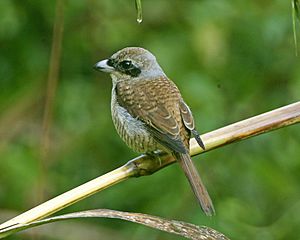Tiger shrike facts for kids
Quick facts for kids Tiger shrike |
|
|---|---|
 |
|
| Female at Panti forest, Malaysia | |
| Conservation status | |
| Scientific classification | |
| Genus: |
Lanius
|
| Species: |
tigrinus
|
The tiger shrike is a small bird found in eastern Asia. It's also called the thick-billed shrike. This bird belongs to a group called shrikes, known for being hunters. Tiger shrikes live in woodland areas. They are often shy and prefer to be alone. Like other shrikes, they hunt and eat small animals. They build their nests in trees and usually lay three to six eggs.
This bird gets its name because its back looks like a tiger's stripes. Its upper parts are reddish-brown with dark bars. Adult male tiger shrikes have white underparts and a grey head with a black mask. Female and young birds are not as brightly colored. Young birds also don't have the grey and black on their heads.
Contents
About the Tiger Shrike
The tiger shrike was first described in 1822 by a Belgian scientist named Pierre Auguste Joseph Drapiez. He placed it in the Lanius group. This group includes about 26 different species of shrikes. The name Lanius means "butcher" in Latin. This is because shrikes sometimes store their prey by sticking it on thorns or sharp branches. Scientists think the tiger shrike is closely related to the brown shrike and bull-headed shrike. There are no different types (subspecies) of the tiger shrike.
What Does a Tiger Shrike Look Like?
The tiger shrike is a small, strong bird. It is about 17 to 19 centimeters (about 7 inches) long. Its thick bill is blue-black with a black tip. Its legs are grey-black.
Male and Female Differences
Adult male tiger shrikes have a reddish-brown back, rump, and shoulders. These parts have blackish bars, making a tiger-like pattern. They have a black forehead and a black mask around their eyes. Their head is grey, and their underparts are white. Sometimes, they have faint bars on their sides.
Female tiger shrikes are duller and browner than males. Their black mask is smaller, and they have less grey on their heads. They also have a thin white stripe above their eye. Young birds have dark, scale-like marks on their head, back, and underparts. They do not have the grey and black colors on their heads. Their bill is pale at the bottom, and their eyes look large because of a pale ring around them.
Birds That Look Similar
- The brown shrike is bigger with a longer tail and a thinner bill. Adult brown shrikes have a plain brown back.
- The bull-headed shrike is also larger and has a longer tail. Adult males have a white patch on their wings.
- The Burmese shrike is thinner and has a longer tail. It has a white wing-patch and a plain chestnut-colored back.
Tiger Shrike Sounds
The tiger shrike's song is a musical warbling sound. They make different harsh calls, too. These include a loud call to mark their territory and a chattering alarm call. They also have a softer, trilling call. They often call from hidden spots. However, males defending their territory will call from a high, open branch.
Where Do Tiger Shrikes Live?

Tiger shrikes breed in cool parts of eastern Asia. They live in deciduous or mixed woodlands. They also like forest edges and farmland with scattered trees. They are found in low areas, usually below 150 meters (about 490 feet) in Russia. In Japan, they are found below 800 meters (about 2,600 feet). In China, they live below 900 meters (about 2,950 feet). Their breeding range includes parts of the Russian Far East, central and eastern China, Korea, and parts of Honshū, Japan.
Migration and Winter Homes
These birds migrate south in August and September. They return to their breeding areas in May and June. They spend the winter in warm, tropical parts of south-east Asia. Their winter homes are below 1,000 meters (about 3,300 feet) above sea-level. This area stretches from south-east China through Burma, Thailand, Laos, and Vietnam. It goes all the way to Malaysia and Indonesia. Some even reach Java, Bali, and Sulawesi. In winter, they live in forest clearings, farm fields, mangroves, and gardens.
Sometimes, tiger shrikes are seen in places they don't usually go. These are called vagrant birds. They have been seen in Hong Kong and the Philippines. One was even found dead in Australia near Fremantle. Another was seen on Christmas Island in April 2008.
The tiger shrike has a wide distribution and a fairly large population. Because of this, BirdLife International says it is not in danger. However, its numbers have gone down recently in Japan and Russia. In Japan, it used to be common, even in the suburbs of Tokyo. Now, it is uncommon and found only in certain areas.
Tiger Shrike Behavior
Feeding Habits
Tiger shrikes mainly eat insects. They especially like grasshoppers, crickets, beetles, and butterflies. They also eat other small creatures with exoskeletons (like spiders). Sometimes, they even catch small birds and lizards. They usually hunt from a perch at the edge of a forest. They are less noticeable when hunting than many other shrikes. They also look for prey among branches and leaves.
Reproduction and Life Cycle
The breeding season for tiger shrikes is from May to July. Pairs form during their migration north or soon after they arrive at their breeding grounds. They stay together as a pair (monogamous). When a male wants to attract a female, he will perch near her. He bows his body up and down and moves his head side to side. While doing this, he sings a soft, quiet version of his normal song. They also do a fast display-flight while calling.
Both the male and female build the nest. It is shaped like a cup. The nest is usually built 1.5 to 5 meters (about 5 to 16 feet) above the ground. They build it on a branch in a tree that loses its leaves in winter. Sometimes, they build it lower down in bushes. The nest is made of stems, twigs, roots, and other plant material. It is lined with soft grasses.
Females lay three to six eggs, but five eggs are most common. The eggs can be different colors. They have dark marks on a whitish, pinkish, or blue-green background. The female sits on the eggs to keep them warm (incubates them) for 14 to 16 days. The young birds leave the nest (fledge) after about two weeks. They stay close to the nest for another two weeks. Usually, a pair lays one group of eggs (clutch) per year. However, if the first clutch is destroyed, they might lay a second one. Strong winds and predators like common magpies can cause many eggs to be lost.



